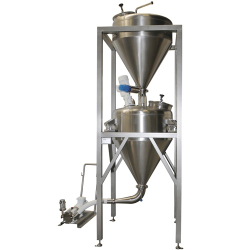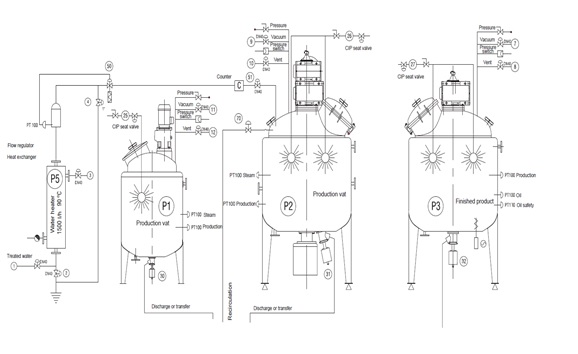Production Skids

What are the steps involved in a production skid construction?
The lead time is normally agreed upfront with the client as well as the engineering design and specifications for what will be delivered. The fabrication will take approved drawings for construction and order the sub components that will be part of the skid. The skid structure will then be completed and components added when available as part of the assembly of same. It is normally tested (FAT) and then packed for shipping and sent to the client.
What is the process in small scale commercial yogurt production?
Moving from the kitchen to small / medium scale yogurt production is achieved with solutions from Flexachem. In general, a farmer or local producer has a source of milk which is then pasteurised, clarified and have sugars added. This mixture is heated & fermented with agitated vessels to achieve the correct pH. This is then cooled and homogenised with the base yogurt sent to a holding tank for pre-filling. Additives such as fruit, flavours etc are added before the filling line and it is then packaged into the desired volume of packing. Flexachem have ready made solutions that keep the lead time, costs and engineering design time down with templated designs that enable quick scale up. We can cater for whipped or set yogurt – depending on your requirement.
What is the process in a mayonnaise production skid?
There are two areas, continuous and batch production, that Flexachem can assist with for your mayonnaise production. In general, the ingredients of oil, spices, water, sugar, lemon juice, vinegar and egg are combined into a vessel. The first stage would be to integrate the ingredients into a tank and use high shear mixers to blend in everything as a pre-emulsion. This is followed by homogenisation / emulsifier pump and sent to pre-filling tank. With broader ranges of flavours and additives, these can be incorporated into the mayonnaise also. Depending on the volume you wish to produce, Flexachem can cater for your requirements to suit throughput and budget
What is the process in a pharmaceutical syrup production skid ?
Pharmaceutical syrups are produced by mixing purified water, sweeteners, active ingredients (API), aromas, flavours and other ingredients (thickeners, etc.). The ingredients are added by means of metering or dosing systems like flow meters and load cells to one or more reactors. The order and quantity of the ingredients to add is specified in the recipe. Usually, preparations are heated before finishing the addition of components. Solid products are added by means of solid-liquid blenders or vacuum systems. When the process is finished, the end product is filtered (if required) and sent to a storage tank. The product is transferred from the storage tanks to the filling machines by pumps. Flexachem can support your requirements via our partners and have readily available templated designs to support 1000 and 2000 litres batch sizes. Larger batches and other complexities can be added via modular design.
What is the process in a cosmetic or pharmaceutical cream production skid?
Creams can be divided into two main groups depending on their use — pharmaceutical and cosmetic/industrial. The difference between these types lies in the fact that pharmaceutical creams contain an active ingredient (medicinal reagent) which is added separately, whereas the others do not. Despite this main difference, however, the flow of production is quite similar.
Preparation – This is where get the fats or wax ready to melt in the first phase. Hot water and active ingredients are prepared for the initial mixing/blending cycle also
Mixing & Melting – the fats and waxes are melted and added to the hot water. An emulsifier is switched on to reduce the particle size and bring the mixture together with consistent particle size. Active ingredients, colourings etc are added and mixed through thoroughly.
Finished product – this is the transfer to the holding tanks / pre-filling line etc. This can be via vacuum / transfer pumps depending on the product type.
What is the process in a food sauce production skid?
These skids are specially designed for the production of sauces with or without solid ingredients. These skids can be used to produce formulas that require heating, cooling, cooking, dispersal, mixing and homogenisation. The processes can be single-stage or multi-stage. Obviously, the means of adding the ingredients, and the point at which they are added, can also vary. Some examples include ketchup, pasta sauces, jams and fillings and vinaigrette. Given the wide number of variables and ingredients, Flexachem have a solution that provides great flexibility in operation. As a summary, the skid will cater for the addition of basic ingredients (solid & liquids) and combining them using high shear agitators or emulsifiers and low shear blending agitators. The product is then transferred via pumps to a filling line.
How can Flexachem help you?
Flexachem have a number of templated production skid solutions to cater for these production needs. Via our partners, we can provide a full turnkey solution including automation and design.
If you have a particular application in mind, why not contact one of our Product Specialists.
Contact our Process Equipment Team:
Michael Bradley (External) – Mob: 086 047 6178
Internal Team
Ken Killoughy – Tel: 021 461 7210
Ross O’Donovan – Tel: 021 461 7230
Vicki McGrath – Tel: 021 461 7207
Tel: 021 461 7200


